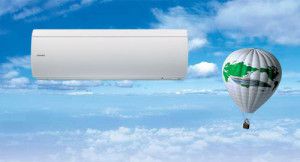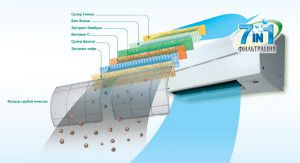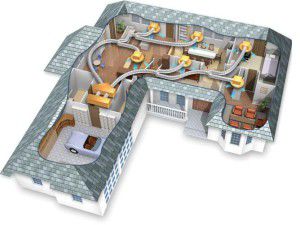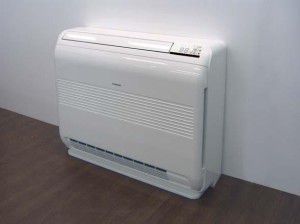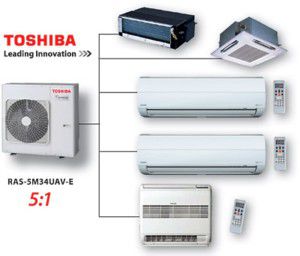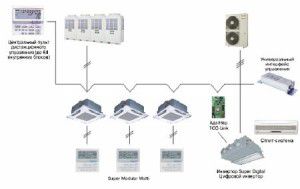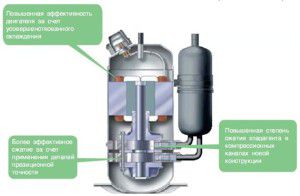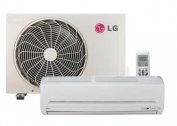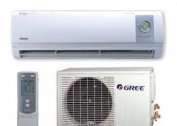Exceptional build quality, best performance and sophisticated functionality presented in Japanese air conditioners Toshiba, which not only cool or heat, but also actively purify the air, creating a healthy and comfortable atmosphere in the room.
Product Range Overview
This trademark offers a large selection of two-component (split) and multi-split systems with heterogeneous internal modules, multi-zone VRF units and heat pumps.
The TOSHIBA component system range has several inverter-controlled air conditioning ranges that have gained the most popularity among customers due to their energy-efficient operation. This was achieved due to the fact that the device operates continuously, without unnecessary shutdowns and turns on, and the power is regulated depending on external conditions, to which a DC compressor is easily adapted.
Wall split systems
In wall splits, the TOSHIBA inverter air conditioners in the N3KVR series, in addition to a stylish design and minimal electricity costs, have a powerful filtration system with several levels of cleaning.
These are the only climate control devices on the market that have a built-in real cleaner. It is able to produce air processing several times faster.
Additionally, the system is equipped with ionic, antibacterial and plasma filters - this is a complete protection against bacteria, viruses, dust, dirt, wool and pollen from the other series of inverters.
The functional features of standard and inverter TOSHIBA wall-mounted air conditioners include:
- fast achievement and exact maintenance of the established temperature parameters;
- low noise level of both units;
- the ability of some series of devices to operate at -20 ° C on the street;
- the use of safe-type freon in most devices;
- drainage mode;
- the presence of a timer for a day, the "Night Sleep" mode, self-diagnosis and automatic change of modes.
The color performance of wall split systems is quite diverse. White, silver and black panels of indoor units can fit into any interior.
In two-component splits and multi-split systems, the installation can include not only wall-mounted indoor units, but also cassette, channel, and console ones.
Cassette Split Systems
TOSHIBA cassette air conditioners are mainly represented by 4-line models of standard and more compact sizes. They are easily integrated into the cell of the suspended ceiling structure and distribute the air volume in several directions. This leads to the absence of drafts in the room and the cleanliness of the distribution grid itself - no dust is collected on it.
Compact cassette units correspond to energy class A, while having high cold and heat production rates reaching 11.2 kW. The noise when the air conditioner is on is like a human whisper. This type of equipment is best suited for rooms with ceilings from 3.5 m and an area of up to 125 m².
The catechin filter, automatic mode switching, easy access for preventative maintenance, many modes and settings make the cassette air conditioners of this manufacturer very convenient to use.
Channel split systems
The duct system of TOSHIBA ducted air conditioners is distinguished by the fact that the air distribution devices can be installed anywhere, and this allows you to supply air to rooms of any shape. The whole structure is hidden in the false ceiling, so the interior is not disturbed in any way.
All channel devices of this brand (medium and high pressure) are characterized by energy efficiency, increased external static pressure and a smooth distribution of air flows. There is a built-in drainage pump that allows you to drain condensate to any place, which, if necessary, is installed in the device.
A duct-type air conditioning system can not only recycle the air in the room, but also mix fresh from the street, and also cool several neighboring rooms at once.
Console Split Systems
The bivariate installation and design of console (floor-to-ceiling) air conditioners of this brand makes them convenient to use and easy to install. They do not take up too much space. The internal device is mounted either on the wall just above the floor or on the ceiling. Such an air conditioner does not require suspension structures or ducting, unlike cassette and channel splits, but it has practically the same power and accuracy of maintaining the temperature.
Console systems have many convenient modes and functions, namely:
- drainage and ventilation;
- floor heating mode;
- adjustment of blinds;
- on and off timer;
- economy mode.
This climate technology can be used as heating radiators, if you install the module under the window.
Multi-split and multi-zone systems
A multi-block (multi) split system allows you to cool and heat up to five neighboring rooms at the same time. 2 to 5 indoor units are connected to one outdoor unit. TOSHIBA has both inverter and non-inverter series of air conditioners for making combinations of multi-split systems. As internal modules, devices of various types can be used. Economical electricity consumption, power, noiselessness, active filtration and multifunctionality are the main advantages of multi-unit systems of this manufacturer. For large buildings, TOSHIBA manufactures multi-zone variable flow refrigerant VRF systems. They can combine up to 4 outdoor and 48 different types of indoor modules.
There are 3 series of multi-zone systems that differ in power characteristics: SMMS mini - up to 15 kW, SHRM - 48 kW, SMMSi - 150 kW. Moreover, all the components of these systems, connected by a single connecting trunk, can be interconnected.
More favorable cost of operation, many functions, 3 control options (individual, centralized and network), maintaining temperature with maximum accuracy, meeting the needs of several dozen rooms with completely different requirements - these are the main features of VRF systems from this Japanese company.
All devices are exclusively Japanese assembly. The main part of TOSHIBA air conditioners is able to operate at temperatures up to -15-20 ° С in winter completely without failures.
Marking
A cipher from a set of letters and numbers is the marking or index of TOSHIBA air conditioners, which indicates differences from each other not only in type and series, but also in technical and functional parameters.
No company currently has uniform standards for letter marking. It may vary depending on the year of manufacture of the product and even small innovations in the control board. But all this data is extremely important when operating and maintaining the device.
All the customer needs to understand is the difference between TOSHIBA air conditioners by index in digital notation.
The ciphers 07, 10, 13, 16, 18, 24, 30 in the marking usually correspond to the maximum power that the air conditioner can achieve when working on cooling. These codes will correspond to 2 kW; 2.5 kW; 3,5 kW; 4.5 kW; 5 kW; 6.5 kW and 8 kW.
For all other distinguishing features of TOSHIBA air conditioners, store managers or employees of an official representative office in Russia can consult the customer index.
Repair and spare parts
Device malfunctions from this manufacturer are extremely rare. In most cases, breakdowns occur due to non-compliance with the installation and operation rules according to the instructions.
Repair work on the replacement of spare parts and cleaning of air conditioners TOSHIBA should be done only by a qualified master, since Japanese climate control devices have the most complex structural features.
As practice shows, the malfunctions detected by the user are not so significant and require small interventions by the repair team. Typically, people may experience the following:
- the air conditioner “flows” or blows with warm air;
- the light indication does not work;
- automatic restart of the system is constantly triggered;
- the remote control does not work;
- modes switch too slowly, the device "thinks" for a long time.
Most often in such cases, fixing the problem may require:
- Freon refueling;
- cleaning the drainage system;
- cleaning the air filters of the indoor unit;
- troubleshooting electronics issues;
- replace the battery in the remote control.
If you suspect a malfunction, you should immediately call the appropriate services and read the instructions.
Serious failures of TOSHIBA air conditioners require replacement of such spare parts as compressor, magnetic starter, outdoor unit capacitor, control board, 4-way valve and so on.
To avoid the replacement of expensive spare parts, preventative maintenance should be carried out regularly and the operating instructions should be followed. If the buyer does not comply with these requirements, the manufacturer does not bear any responsibility for the equipment.
Remote Control Instructions
You can familiarize yourself in detail and in an accessible form with all the modes and functions of air conditioners using the instructions for the remote control for the Toshiba air conditioner. To begin with, it is worth studying the information about all the keys (indicators) of the device - there are a lot of them. And although the device itself is quite informative, it will be difficult to figure out how to turn on the timer or high power mode without appropriate documentation.
The instructions for the remote control say that the TOSHIBA air conditioner can be controlled using the panel on the device itself in case of a malfunction of the remote control.
If the user wants to store the most frequently used operations in the device’s memory, press the MEMO button while the required mode is operating.
It should be remembered that the automatic restart operation was not programmed initially at the factory, so it should be activated on the device by the user himself. Any remote control for a Toshiba air conditioner contains instructions on how to do this.
Customer reviews
There are almost no negative comments among customer reviews of TOSHIBA brand air conditioners. These climate control devices are several levels above any of their competitors. All users noted that these devices:
- have rich and 100% working functionality;
- represent many advanced technical solutions in terms of design features, which saves electricity and does not hear the operation of the device;
- serve for at least 10-15 years with constant daily use;
- require minimal maintenance and minor repair costs;
- They have a stylish design and compact size.
Judging by the reviews of TOSHIBA air conditioners, buyers are not even afraid of the rather high price for these devices. Although there are exceptions.Of course, this technique is not included in the ranks of the economy segment, but inexpensive models can be found. For example, a non-inverter type of compressor control always reduces the cost of air conditioning. And the absence of some additional modes and functions will not affect the ability of the device to cool and heat the room. These two factors may well be considered when buying. It is worth considering that the remote control for the Toshiba air conditioner also costs a lot of money and it is not recommended to lose it.
